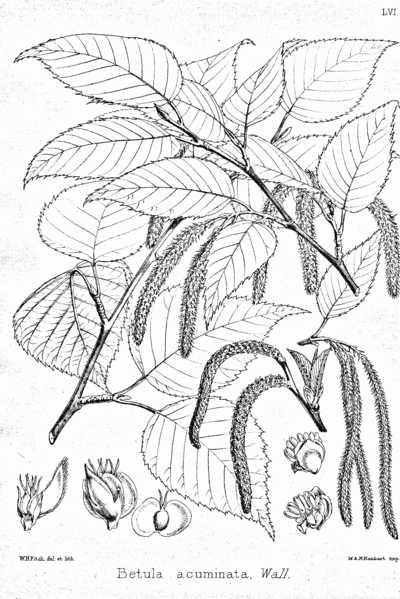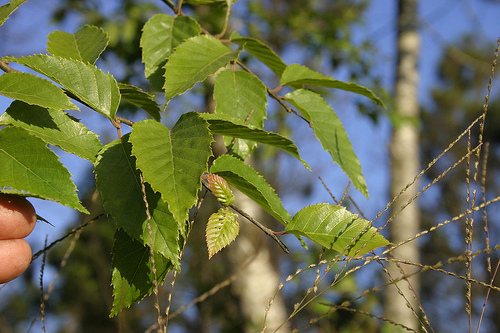 |
|
http://commons.wikimedia.org/wiki/File:Betula_alnoides_Bra56.png |
 |
| http://flickr.com/photos/8108294@N0 |
Translate this page:
Summary
Physical Characteristics

 Betula alnoides is a deciduous Tree growing to 40 m (131ft 3in) at a fast rate.
Betula alnoides is a deciduous Tree growing to 40 m (131ft 3in) at a fast rate.
See above for USDA hardiness. It is hardy to UK zone 8. It is in flower in April, and the seeds ripen in September. The species is monoecious (individual flowers are either male or female, but both sexes can be found on the same plant) and is pollinated by Wind.
Suitable for: light (sandy), medium (loamy) and heavy (clay) soils, prefers well-drained soil and can grow in heavy clay soil. Suitable pH: mildly acid, neutral and basic (mildly alkaline) soils. It can grow in semi-shade (light woodland) or no shade. It prefers moist soil.
UK Hardiness Map
US Hardiness Map
Synonyms
B. acuminata.
Plant Habitats
Woodland Garden Canopy; Secondary;
Edible Uses
Edible Parts: Inner bark
Edible Uses:
Inner bark - can be dried, then ground into a powder and added to flour for use in making bread, cakes etc[177]. Inner bark is generally only seen as a famine food, used when other forms of starch are not available or are in short supply[K].
References More on Edible Uses
Medicinal Uses
Plants For A Future can not take any responsibility for any adverse effects from the use of plants. Always seek advice from a professional before using a plant medicinally.
Antidote Antiseborrheic
The plant has been used as an antidote in the treatment of snake bites[240, 243]. A decoction of the bark is used to treat dislocated bones[272].
References More on Medicinal Uses
The Bookshop: Edible Plant Books
Our Latest books on Perennial Plants For Food Forests and Permaculture Gardens in paperback or digital formats.

Edible Tropical Plants
Food Forest Plants for Hotter Conditions: 250+ Plants For Tropical Food Forests & Permaculture Gardens.
More

Edible Temperate Plants
Plants for Your Food Forest: 500 Plants for Temperate Food Forests & Permaculture Gardens.
More

More Books
PFAF have eight books available in paperback and digital formats. Browse the shop for more information.
Shop Now
Other Uses
Paper Wood
The thin layer of outer bark is used as a paper[61]. The juice of the bark is used for decorating wood[272]. Wood - moderately hard, close grained, strong, durable[146, 158]. Used for minor construction[272].
Special Uses
Dynamic accumulator
References More on Other Uses
Cultivation details
Succeeds in a well-drained loamy soil in a sheltered position[11, 200]. Grows well in heavy clay soils. Dislikes wet soils[200]. Shade tolerant[200]. This species is not very hardy and does not always succeed outdoors in Britain but some provenances should be hardy[11]. Hybridizes freely with other members of this genus[50]. Trees are notably susceptible to honey fungus[200].
References Carbon Farming Information and Carbon Sequestration Information
Temperature Converter
Type a value in the Celsius field to convert the value to Fahrenheit:
Fahrenheit:
The PFAF Bookshop
Plants For A Future have a number of books available in paperback and digital form. Book titles include Edible Plants, Edible Perennials, Edible Trees,Edible Shrubs, Woodland Gardening, and Temperate Food Forest Plants. Our new book is Food Forest Plants For Hotter Conditions (Tropical and Sub-Tropical).
Shop Now
Plant Propagation
Seed - best sown as soon as it is ripe in a light position in a cold frame[78, 80, 113, 134]. Only just cover the seed and place the pot in a sunny position[78, 80, 134]. Spring sown seed should be surface sown in a sunny position in a cold frame[113, 134]. If the germination is poor, raising the temperature by covering the seed with glass can help[134]. When they are large enough to handle, prick the seedlings out into individual pots and grow them on in a cold frame for at least their first winter. Plant them out into their permanent positions in late spring or early summer, after the last expected frosts. If you have sufficient seed, it can be sown in an outdoor seedbed, either as soon as it is ripe or in the early spring - do not cover the spring sown seed. Grow the plants on in the seedbed for 2 years before planting them out into their permanent positions in the winter[78, 80, 113, 134].
Other Names
If available other names are mentioned here
Native Range
TEMPERATE ASIA: China (Fujian Sheng, Guangxi Zhuangzu Zizhiqu, Hainan Sheng, Hubei Sheng, Sichuan Sheng, Yunnan Sheng (south)) TROPICAL ASIA: Bangladesh, Bhutan, India (Assam, Manipur, Nagaland, Uttar Pradesh), Nepal, Laos, Myanmar, Thailand, Vietnam
Weed Potential
Right plant wrong place. We are currently updating this section.
Please note that a plant may be invasive in one area but may not in your area so it's worth checking.
Conservation Status
IUCN Red List of Threatened Plants Status :

| Related Plants
|
| Latin Name | Common Name | Habit | Height | Hardiness | Growth | Soil | Shade | Moisture | Edible | Medicinal | Other |
| Alnus acuminata | Alder | Tree | 25.0 |
10-12
| F | LMH | SN | M | 0 | 2 | 3 |
| Alnus cordata | Italian Alder | Tree | 25.0 |
5-9
| F | MH | SN | DMWe | 0 | 0 | 4 |
| Alnus glutinosa | Alder, European alder , Common Alder, Black Alder | Tree | 25.0 |
3-7
| F | MH | SN | MWe | 0 | 3 | 5 |
| Alnus hirsuta | | Tree | 18.0 |
3-7
| | MH | SN | MWe | 0 | 0 | 2 |
| Alnus incana | Grey Alder, Speckled alder, Thinleaf alder, White Alder | Tree | 18.0 |
2-6
| F | MH | SN | DMWe | 1 | 0 | 3 |
| Alnus japonica | Japanese Alder | Tree | 22.0 |
4-8
| F | MH | SN | DMWe | 0 | 1 | 2 |
| Alnus jorullensis | Mexican alder, Evergreen Alder | Tree | 25.0 |
7-12
| F | LMH | SN | MWe | 0 | 0 | 3 |
| Alnus maritima | Seaside Alder, Beach Alder | Tree | 9.0 |
3-7
| M | MH | N | MWe | 0 | 0 | 3 |
| Alnus maximowiczii | | Tree | 9.0 |
4-8
| | MH | SN | MWe | 0 | 0 | 2 |
| Alnus nepalensis | Nepalese Alder | Tree | 22.0 |
8-11
| F | MH | SN | MWe | 0 | 1 | 3 |
| Alnus nitida | West Himalayan Alder | Tree | 30.0 |
7-10
| | MH | SN | DMWe | 0 | 1 | 3 |
| Alnus rhombifolia | White Alder | Tree | 12.0 |
8-11
| F | MH | SN | MWe | 1 | 2 | 2 |
| Alnus rubra | Red Alder, Oregon Alder | Tree | 20.0 |
6-8
| F | MH | SN | MWe | 2 | 2 | 4 |
| Alnus rugosa | Speckled Alder | Tree | 22.0 |
2-6
| F | MH | SN | MWe | 0 | 2 | 3 |
| Alnus serrulata | Smooth Alder, Hazel alder | Shrub | 4.5 |
3-9
| | MH | N | MWe | 0 | 2 | 2 |
| Alnus sinuata | Sitka Alder | Shrub | 4.0 |
2-9
| F | MH | SN | MWe | 1 | 1 | 3 |
| Alnus tenuifolia | Mountain Alder, Thinleaf alder | Tree | 9.0 |
5-7
| F | MH | SN | MWe | 1 | 2 | 3 |
| Alnus viridis crispa | American Green Alder | Shrub | 3.0 |
4-8
| | MH | SN | MWe | 1 | 2 | 3 |
| Betula alleghaniensis | Yellow Birch, Swamp Birch | Tree | 12.0 |
3-7
| F | LMH | SN | M | 3 | 2 | 4 |
| Betula ermanii | Gold Birch | Tree | 25.0 |
3-7
| F | LMH | SN | M | 0 | 1 | 3 |
| Betula glandulosa | Scrub Birch | Shrub | 2.0 |
0-0
| | LMH | SN | M | 2 | 1 | 3 |
| Betula kenaica | Kenai Birch | Tree | 12.0 |
0-0
| F | LMH | SN | M | 3 | 1 | 3 |
| Betula lenta | Cherry Birch, Sweet birch, Black Birch, Cherry Birch | Tree | 24.0 |
3-7
| F | LMH | SN | M | 3 | 3 | 4 |
| Betula nana | Dwarf Birch | Shrub | 0.3 |
0-0
| | LMH | SN | M | 2 | 2 | 3 |
| Betula nigra | River Birch, Black Birch, Red Birch, Water Birch, River Birch | Tree | 20.0 |
3-9
| F | LMH | SN | M | 3 | 2 | 2 |
| Betula occidentalis | Water Birch | Tree | 8.0 |
3-7
| F | LMH | SN | M | 3 | 2 | 4 |
| Betula papyrifera | Paper Birch, Mountain paper birch, Kenai birch | Tree | 20.0 |
0-0
| F | LMH | N | DM | 3 | 2 | 4 |
| Betula pendula | Silver Birch, European white birch, Common Birch, Warty Birch, European White Birch | Tree | 20.0 |
2-6
| F | LMH | N | DM | 3 | 3 | 5 |
| Betula platyphylla | White Birch, Asian white birch, | Tree | 20.0 |
3-6
| F | LMH | N | DM | 2 | 2 | 2 |
|
|
Growth: S = slow M = medium F = fast. Soil: L = light (sandy) M = medium H = heavy (clay). pH: A = acid N = neutral B = basic (alkaline). Shade: F = full shade S = semi-shade N = no shade. Moisture: D = dry M = Moist We = wet Wa = water.
Now available:
Food Forest Plants for Mediterranean Conditions
350+ Perennial Plants For Mediterranean and Drier Food Forests and Permaculture Gardens.
[Paperback and eBook]
This is the third in Plants For A Future's series of plant guides for food forests tailored to
specific climate zones. Following volumes on temperate and tropical ecosystems, this book focuses
on species suited to Mediterranean conditions—regions with hot, dry summers and cool, wet winters,
often facing the added challenge of climate change.
Read More
Expert comment
Author
Buch.-Ham. ex D.Don.
Botanical References
1151200
Links / References
For a list of references used on this page please go here
Readers comment
| Add a comment |
|
If you have important information about this plant that may help other users please add a comment or link below. Only comments or links that are felt to be directly relevant to a plant will be included. If you think a comment/link or information contained on this page is inaccurate or misleading we would welcome your feedback at [email protected]. If you have questions about a plant please use the Forum on this website as we do not have the resources to answer questions ourselves.
* Please note: the comments by website users are not necessarily those held by PFAF and may give misleading or inaccurate information.
To leave a comment please Register or login here All comments need to be approved so will not appear immediately.
|
Subject : Betula alnoides
|
|
|
|